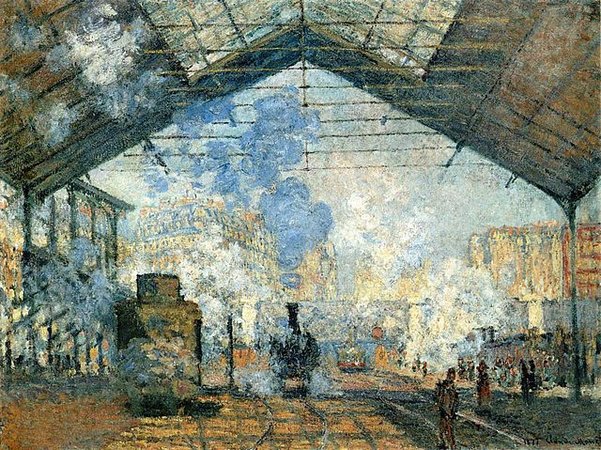Impressionist paintings refer to art created by a group of primarily French painters in the early part of the 20th century. This movement was inspired by their observations of the world around them, as well as their personal experiences. The term “Impressionist” is used to describe paintings that are meant to capture fleeting moments and sensory impressions.
These artists experimented with different approaches, techniques and subject matter, which resulted in a wide variety of their outputs. In this article, we’ll explore what an Impressionist painting looks like, its key attributes and how you can identify one if you see one.

What is an Impressionist Painting?
Impressionist paintings are non-realistic in their subject matter, style and palette. They are typically created using oil paint and are created with the intent of capturing certain moments in time.
Impressionist painters purposely ignored traditional academic styles in painting and instead focused on capturing the fleeting nature of life, using bright colours and experimenting with different techniques. As well as the typical Impressionist painting, there is also the Impressionist lithograph, which is a printing press print of an Impressionist painting.
Impressionist paintings attempt to capture the vivid and often fleeting qualities of life through the use of bright colours, subject matter and a more simplified style. Impressionist painters were known for focussing on the effects of light, capturing the mood and atmosphere of their scenes.
The Impressionist style became popular in the early 20th century as artists experimented with new techniques, inspired by emerging technologies that enabled them to capture light directly.
Key Impressionist Painting Attributes
Subject Matter
The content of an Impressionist painting is often related to the subject matter of Impressionist paintings. This could be a fleeting moment in time or a subject that is common in everyday life. Impressionist paintings are typically not focused on a specific narrative, but instead, try to capture the atmosphere and mood of the scene.
Style
Impressionist paintings often have a simplified style, with less detail and complexity than realist paintings. This is to highlight the mood and atmosphere of the scene, as opposed to accurately capturing the subject matter. The simplified style of Impressionist paintings is often more bold and more vibrant.
Colour Palette
Impressionist paintings often use primary colours, instead of muted tones to create a more vibrant and striking style. Realist paintings tend to use a more muted palette, with colours that are more closely related to their shades.
Subject Matter and Style
Impressionist paintings often come from a distinct style, known as Impressionism. This style is rooted in the Impressionist movement and originated in Paris, using bright and bold colours with a simplified style. Realist paintings are typically rooted in Realism, a style that is realistic in its subject matter and style, attempting to accurately capture the subject matter.
Differences Between Impressionist and Realist Paintings
Subject Matter
The subject matter of an Impressionist painting is typically related to the atmosphere and mood of the scene, rather than being focused on a narrative or accurate portrayal of the subject matter. Impressionist paintings are highly stylized and simplified, using bright colours and a simplified style that is more bold and more striking. Realist paintings attempt to accurately portray the subject matter.
Style
The style of an Impressionist painting is typically more simplified and bold, with less detail and complexity than a Realist painting. Impressionist paintings are highly stylized, using simplified techniques and bold colours to create a striking and memorable style. Realist paintings are typically rooted in the Realist style, attempting to accurately portray the subjects.
Colour Palette
Impressionist paintings often use a more vibrant palette, with bright primary colours instead of muted tones. The palette of an Impressionist painting is often more simplified, using only a few colours while accentuating the boldness of the painting. Realist paintings are typically rooted in Realism, using a more muted palette with tones that are closely related to their shades.
Subject Matter and Style
An Impressionist painting is typically not rooted in a certain style or movement but is instead rooted in the Impressionist movement. The subject matter of an Impressionist painting is typically related to the atmosphere and mood of the scene, rather than being focused on a narrative or accurate portrayal of the subject matter.
How to Identify an Impressionist Painting
If you come across an Impressionist painting in a public or private gallery, museum or art gallery, you can usually identify one as it was created by a member of the Impressionist movement.
Impressionist paintings are typically lighter in colour, with vivid and striking colours, as opposed to a more muted palette used by Realist artists. Impressionist paintings are also typically less detailed and complex than Realist paintings, with more attention being paid to creating a striking and memorable style.
Impressionist paintings typically use brighter primary colours to create a more striking and memorable style, while Realist paintings are typically rooted in realism and are less complex and less striking. Impressionist paintings are also typically more stylized, with less attention being paid to the accurate subject matter, while Realist paintings are typically more focused on the accurate subject matter.
Impressionists are also known to paint landscapes, cityscapes and other scenes that are not focused on a specific subject.
Conclusion
Impressionist paintings are typically visually striking and vibrant, with a simplified and stylized style that is highly simplified and stylized. Impressionist paintings are typically less detailed and complex than Realist paintings, with more attention being paid to creating a striking and memorable style. Impressionist paintings are typically rooted in the Impressionist movement, creating a distinct style from other movements that are typically less rigid in their style.
Impressionist paintings are also typically more stylized, with less attention being paid to the accurate subject matter, while Realist paintings are typically more focused on the accurate subject matter. Impressionists are also known to paint landscapes, cityscapes and other scenes that are not focused on a specific subject.





